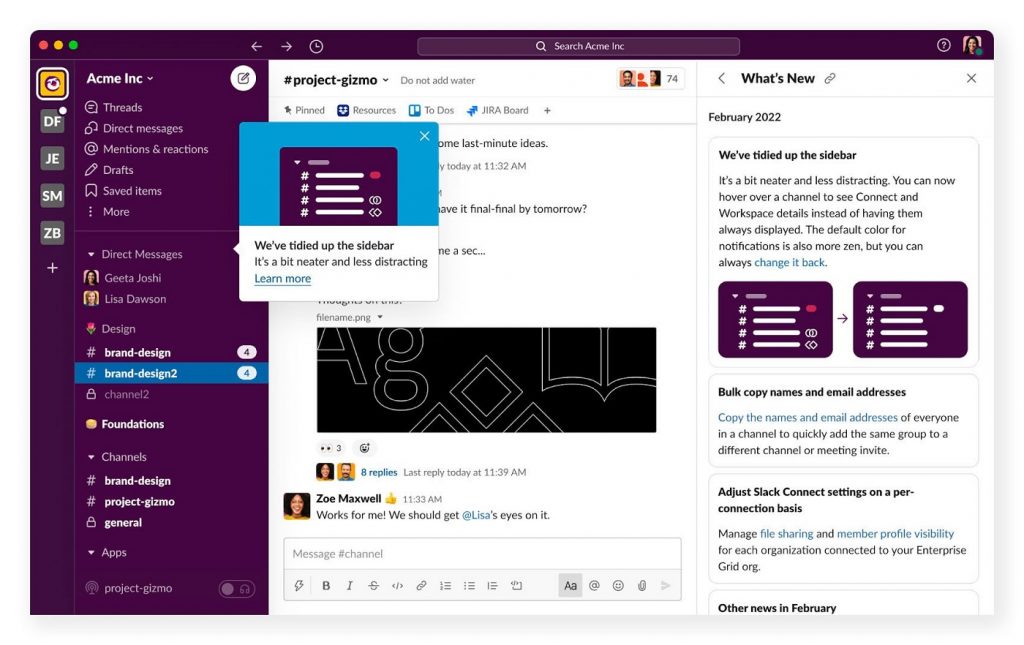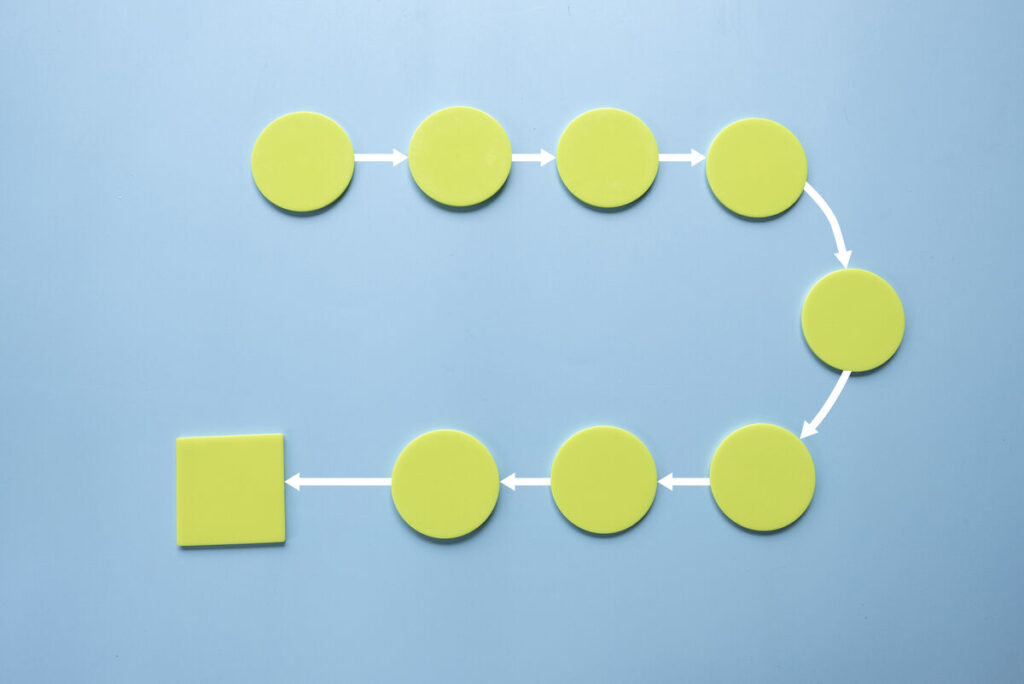Key takeaways
Slack vs Trello: How are they different?
| Slack | Trello | |
|---|---|---|
| File management | Sharing within chats | Attachments on cards |
| Task management | Integrations for tasks | Boards and cards system |
| Direct and group messaging | Built-in messaging system | N/A (Communication via comments on tasks) |
| Workflow automation | Workflow Builder for communication processes | Butler for task-based automation |
| Integration | Wide range, including apps for communication and productivity | Power-Ups for enhanced project management features |
| Visit Slack | Visit Trello |
What is Trello?

If you’re looking for an easy way to manage tasks and simple projects, Trello, developed by Atlassian, is an excellent option to explore. This system organizes tasks into cards, which you can then categorize into different columns on a Kanban board. Trello has templates for different workflows, such as content writing, podcast production, video production, Scrum processes, sales pipelines, and even wedding planning.
Some of Trello’s key features include:
With features comparable to Slack, Trello allows easy collaboration through comments, attachments, and shared boards, mirroring Slack’s communication-focused environment. Trello’s integration with various third-party apps, including Slack, enhances its collaborative and productivity potential. This integration offers a seamless experience for users accustomed to Slack’s ecosystem.
Moreover, Trello’s real-time sync across devices secures constant connectivity and collaboration, akin to Slack’s instant messaging and team communication features.

Pros
Cons
Learn more about Trello in our video overview:
If you’re looking for other project management software options, explore our list of the top Trello alternatives.
What is Slack?

Slack was initially developed by Slack Technologies, Inc. and was later acquired by Salesforce in 2020. This acquisition has positioned Slack within Salesforce’s suite of business tools, as Salesforce can also be used in project management.
Nowadays, Slack is widely recognized as a communication and collaboration platform. It offers instant messaging, file sharing, and team channels. While Slack is not primarily designed as a project management solution, it excels at streamlining team interactions and ensuring efficient information flow.
However, Slack typically relies on third-party integrations for comprehensive project management functionalities. This approach allows it to integrate with various project management tools, thus enhancing its utility without compromising its core strengths in communication and collaboration.
Here are some Slack’s key features:
Slack offers several key features focused on enhancing team communication and collaboration. It provides channels for organized conversations by topic, team, or project. Direct messaging and group messaging in Slack facilitate quick discussions, akin to Trello’s comment features on cards.
File sharing within conversations in Slack parallels Trello’s attachment feature on cards. Integration with third-party applications, including project management systems like Trello, Asana, and Wrike, allows Slack to complement and extend the capabilities of these tools. Additionally, Slack Connect and the Workflow Builder provide enhanced collaboration with external partners and automation of routine tasks, features not natively present in Trello.

Pros
Cons
Learn more about Slack in our video review:
Trello vs. Slack: A detailed comparison
| Trello | Slack | |
| User interface and ease of use | Yes | Yes |
| Task management | Yes | No |
| Instant messaging | No | Yes |
| Video conferencing | No | Yes (Requires integration) |
| Integration with other tools | Yes | Yes |
| Notification system | Yes | Yes |
| Collaboration features | Yes | Yes |
| Project tracking and reporting | Yes | No |
| Customization and flexibility | Yes | Yes |
| Mobile app experience | Yes | Yes |
| Pricing and plans | Yes | Yes |
| Security features | Yes | Yes |
| Offline accessibility | No | No |
| Customer support and resources | Yes | Yes |
Pricing
The pricing structures of Trello and Slack differ primarily in focus and scaling. Trello’s structure is designed to cater to project management needs. It has a range of plans that scale with additional project management features for larger teams or more complex projects. Slack’s pricing, meanwhile, is geared towards scaling communication features, with plans that expand on messaging history, integrative capabilities, and advanced administrative tools as you move up the tiers.
| Trello | Slack | |
| Free plan available | Yes | Yes |
| Monthly subscription | Yes (Standard/Premium) |
Yes (Standard/Plus) |
| Annual subscription discount | Yes | Yes |
| Per user pricing | Yes | Yes |
| Tiered pricing levels | Yes | Yes |
| Enterprise plan | Yes | Yes |
| Additional features at extra cost | Yes (Power-Ups) |
Yes (Add-ons) |
| Non-profit discounts | Yes | Yes |
| Free trial for paid plans | Yes | Yes |
Workflow automation
Trello and Slack serve distinct roles in workflow management. With its visual board-based system, Trello can enhance task tracking and project progress visualization. It’s tailored for structuring and overseeing tasks and projects and offers an organized view of responsibilities and deadlines.
On the other hand, Slack provides a platform for real-time messaging, file sharing, and tool integration. While Trello organizes the workflow, Slack streamlines internal communication, making it ideal for quick discussions, document sharing, and team interactions.
Together, they offer a comprehensive approach to managing team projects’ structural and communicative aspects for a smoother and more efficient workflow.
| Trello | Slack | |
| Trigger-based actions | Yes | Yes |
| Automated task assignments | Yes | Yes |
| Due date reminders | Yes | Yes |
| Automated status updates | Yes | No |
| Scheduled messages/reminders | No | Yes |
| Email-to-task automation | Yes | No |
Integrations
Trello and Slack differ significantly in their approaches to integrations. Trello’s integrations allow users to connect with different productivity tools like time trackers, calendar apps, and other PM software.
Slack, however, focuses on integrations that bolster its communication and collaboration features. It integrates with many services, from project management tools like Trello to file-sharing apps and developer tools. This functionality makes Slack a central hub for team interactions and information flow.
While Trello integrates tools to enhance individual and team productivity in project management, Slack’s integrations are geared toward creating an interconnected communication ecosystem that supports a variety of workflows.
| Trello | Slack | |
| Native file storage integration | Yes | Yes |
| CRM integration | Yes | Yes |
| Real-time data sharing | No | Yes |
| Custom bots and apps | No | Yes |
| Email integration | Yes | Yes |
| Project management tool integration | Yes | Yes |
| Communication platform integration | No | Yes |
Collaboration
Trello and Slack serve distinct collaborative functions: Trello is a workflow management system ideal for project organization. It offers visual Kanban boards to track and manage tasks and highlights who’s working on what and their progress. This makes it excellent for structured project management.
On the other hand, Slack is a communication-centric platform designed to centralize and streamline workplace conversations, replacing emails and texts with a more organized, searchable system. It excels in facilitating real-time communication and information sharing through channels and direct messages. Its features make it more suited for dynamic team interactions and decision-making.
| Trello | Slack | |
| Messaging and chat capabilities | No | Yes |
| Video and voice call functionality | No | Yes |
| Board and card system for tasks | Yes | No |
| Project tracking and updates | Yes | No |
| Commenting and feedback on tasks | Yes | Yes |
| Shared workspaces and channels | Yes | Yes |
| Integration with other collaboration tools | Yes | Yes |
Slack vs Trello: Can you use them together?
There are two ways you can make Trello and Slack work together: the Slack Power-Up in Trello and the Trello App for Slack. They’re both useful add-ons, but the one you end up using will depend on which tool you prefer.
For instance, the Slack Power-Up in Trello lets you do the steering from Trello, while the Trello App for Slack lets you do the steering from Slack. This might seem confusing at first, but once you learn how both add-ons work, it all comes together.
But why choose one add-on over another? If you switch back and forth between Trello and Slack regularly, I recommend using both add-ons so you can streamline processes in whichever app you happen to be working in at the moment.
Using Slack in Trello
Let’s rewind for a moment and talk about upgrading to a paid tier in Trello. You can do this to simply get more automation and security features out of Trello as a standalone solution, but you’ll also get a lot of value from unlimited Power-Ups.
Power-Ups take your Trello experience to the next level, and thankfully there’s a nice Slack Power-Up you can get. This add-on lets you remind yourself and others about upcoming due dates on cards. It also lets you assign a board to a specific Slack channel, share cards with someone in a DM or with a group of people in a certain channel, and link to a card in Trello.
Using Trello in Slack
The Trello App for Slack works much the same way that the Slack Power-Up in Trello does, except the roles are reversed. In the previous example, the Slack Power-Up, a user works in Trello to trigger actions in Slack. But in the Trello App for Slack, a user works in Slack to trigger actions in Trello.
You can do this using what Slack calls Slash Commands. These are actions you can take in Slack by simply typing /[command] in the messaging field. Some common examples include:
The Trello App works no differently. Using the Slash Command /trello, you can create new cards straight from Slack. This add-on also lets you attach conversations from Slack to Trello cards, subscribe to updates on a card, update due dates, and join cards and boards.
Trello vs Slack: How to pick?
Trello and Slack, while both serving as pivotal tools in modern work environments, cater to distinctly different purposes.
Trello is primarily a project management tool that offers a visual and intuitive way to organize and track projects through boards and cards. It excels in task delegation, progress tracking, and providing a clear overview of project stages. Hence, it’s ideal for teams that need a structured approach to manage their workflows.
On the other hand, Slack focuses on enhancing team communication. It is a powerful tool for real-time messaging, file sharing, and integrating various work applications, which promotes swift and efficient team interactions. Slack’s strength lies in its ability to facilitate immediate communication, which is why it’s perfect for teams prioritizing ongoing dialogue and quick information exchange.
The choice between Trello and Slack should be based on your specific needs. Trello is an excellent choice if your priority is structured project management with visual task tracking. For teams needing a robust communication platform, Slack is more suitable.
Evaluate your team’s workflow and communication style to decide which tool best fits your requirements.





